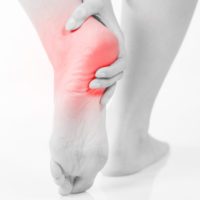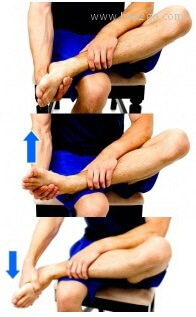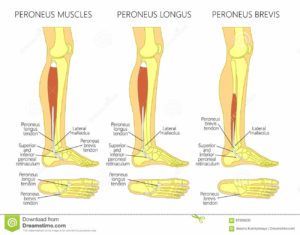Trigger points in muscles on the outside of calf cause ankle and heel pain. Sometimes this pain radiates up into outside of the calf or down into the outside of the foot. Do you know anyone with “weak ankles” and chronic sprains? The weakness of inhibition from these trigger points can cause instability in the ankles.
Of course, we will briefly review trigger point referral patterns for these “Fib” muscles. However, this time, our focus is on the role of the Fibs in maintaining stability at the ankle. Like many other muscles of the lower leg, the fibularis group often works more to control movement than to produce it.
It makes sense. Balancing a broom upside down on your hand requires constant adjustments to maintain balance. From the view of your ankles, the rest of you is just two loosely connected broomsticks with a lot of weight up top. This means that many of the muscles that cross our ankle and the muscles that work on our hip work together to help us remain upright when standing, walking and running.
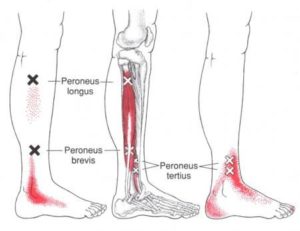 You may activate trigger points in the Fibs if you fall in a way that is typical for an ankle sprain. For instance, twisting or inverting the ankle under your weight will overload the Fibs. In addition, you can develop trigger points in the Fibs if your lower leg is immobilized with an elastic bandage, cast or boot.
You may activate trigger points in the Fibs if you fall in a way that is typical for an ankle sprain. For instance, twisting or inverting the ankle under your weight will overload the Fibs. In addition, you can develop trigger points in the Fibs if your lower leg is immobilized with an elastic bandage, cast or boot.
Sometimes, trigger points in the gluteus minimis refer pain strongly down the outside of the lower leg. This can induce satellite trigger points in the fibularis group. Furthermore, the functional relationship of the hips and ankles in maintaining balance means that other hip issues can manifest in the Fibs and other ankle muscles.
Chronic tension in the Tibs, which oppose the action of the Fibs, can also overload the Fibs and cause trigger points in them – and vice versa!
Treating the fibularis group should always include of targeted compression to the full complement of muscles in the lower legs. Then, we follow each step with movement through the entire range of motion and stretches of the ankle, especially inverting and then everting it.
Compressions
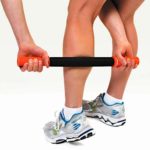 A roller like the Tiger Tail is fantastic for this. Begin by gently rolling the entire lower leg, aiming to increase circulation and warm the muscles up. Gradually increase pressure. Then begin to work a little deeper, searching for tender areas. Move more closely to the trigger points of the Fibs on the outside of the the calf. When you feel you have found it, stop rolling and experiment with gently rocking and and wiggling of the roller on this area, while continuing to maintain pressure, until any pain subsides and the muscle releases.
A roller like the Tiger Tail is fantastic for this. Begin by gently rolling the entire lower leg, aiming to increase circulation and warm the muscles up. Gradually increase pressure. Then begin to work a little deeper, searching for tender areas. Move more closely to the trigger points of the Fibs on the outside of the the calf. When you feel you have found it, stop rolling and experiment with gently rocking and and wiggling of the roller on this area, while continuing to maintain pressure, until any pain subsides and the muscle releases.
Stretches
The same type of movements we used to stretch tibialis posterior are good the the Fibs. First, we move gently between inversion/eversion and plantar flexion/dorsiflexion. Then we start to combine the movements. However, for the Fibs we use inversion as a stretch. For some, this stretch is more effective and less painful in a warm bath.
Other Techniques
We use trigger point pressure release and fascial stretching techniques in most sessions. We also use techniques like “post-isometric relaxation” to help reset the Fibs. In addition, because the muscle is so superficial it responds easily to kinesio taping and hot and cold therapy.
Strengthening
Some runners and athletes may want to more aggressively recondition and strengthen both the Tibs and Fibs. We like some of the stretches and exercises in this video for the Fibs. Note that she is advising about “peroneal tendinitis”, also known as “fibularis tenidinitis”. Although we don’t use that language much, we agree with her on stretching and conditioning the muscles in this area.
Many of us have some variations in our bony structure that affect how our muscles and connective tissue work. Some of these fall into common categories that we work with often.
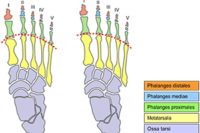 First, if you have trigger points in the Fibs we will usually want to check you for Morton’s Foot Structure (MFS). This common skeletal variation makes your foot want to pronate. So it makes sense that a muscle whose primary function is to resist pronation would be unhappy. A simple correction with a posture control insert is usually all that is needed. Less often, the bones in the foot move too much and the arch has fallen. This requires an appropriate arch support that can be added to the posture control insole.
First, if you have trigger points in the Fibs we will usually want to check you for Morton’s Foot Structure (MFS). This common skeletal variation makes your foot want to pronate. So it makes sense that a muscle whose primary function is to resist pronation would be unhappy. A simple correction with a posture control insert is usually all that is needed. Less often, the bones in the foot move too much and the arch has fallen. This requires an appropriate arch support that can be added to the posture control insole.
Next, we will probably perform a preliminary screening for differences in leg length. Because of the role of the fibs as lower muscular outrigger, a difference in the length of your legs makes these muscles work harder. Finally, we will also probably screen you to see if the two sides of your pelvis are different sizes.
Unsurprisingly, if you have a combination of these structural variations, they will compound each other. Fortunately, we can easily correct all three conditions. This makes other treatments much more effective.
Finally, we return to some possible adjustments in activities that perpetuate problem with the Fibs.
Pointing Your Feet – Any position that increases plantar flexion shortens various muscles of the calf. Collectively, the shortening of these muscles is the number 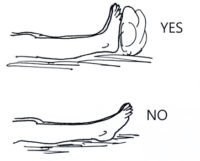 one cause of myofascial pain in the lower leg and foot. This can happen in various ways. For instance, sleeping on your stomach or bed coverings that are too tight or heavy can point your feet. A well placed pillow can help. In addition, a desk chair that is too high without a foot rest will point both feet. Long drives will point the right foot. You can probably think of other examples.
one cause of myofascial pain in the lower leg and foot. This can happen in various ways. For instance, sleeping on your stomach or bed coverings that are too tight or heavy can point your feet. A well placed pillow can help. In addition, a desk chair that is too high without a foot rest will point both feet. Long drives will point the right foot. You can probably think of other examples.
Slanted/Uneven Surfaces – The stabilizing muscles of your ankles are your muscular outriggers. Don’t make them work too hard by running or walking on surfaced that are inclined, slanted to either side, uneven, rocky or unstable.
High Heels – Any high heeled shoe shortens the calf muscles. In addition, they throw your center of mass forward, reducing your base of support. They also increase the lever arm that your ankle muscles have to work against. Spike heels reduce the base of support even more.
Crossing Your Legs – If the two sides of your pelvis are different sizes you may cross your legs to compensate. This can compress the nerve that supplies the Fibs and directly compress fibularis longus. This compression can lead to myofascial dysfunction. This also applies to the common habit of crossing the LOWER legs when reclined or sleeping.
Tight Elastic Support – Consider asking a professional myofascial therapist about these. 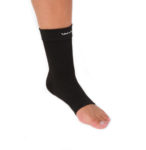 If you feel it is helpful because you are in pain, we will seek to relieve it. If you feel unstable, we will seek to build stability back up. They may be causing pressure on key muscles of your calf, leading to more problems with the Fibs and other important muscles.
If you feel it is helpful because you are in pain, we will seek to relieve it. If you feel unstable, we will seek to build stability back up. They may be causing pressure on key muscles of your calf, leading to more problems with the Fibs and other important muscles.
So, let’s meet the Fibs and get to know a little bit of the anatomy to understand how this muscle group works.
There are three members: fibularis longus, brevis and tertius.
All three muscles originate on fascia of the small, outside bone of the calf (fibula) and tissue that connects the two bones.
For the longus and brevis, their tendons pass downward, behind the protuding bone of the ankle and runs under the foot, attaching there.
This means that its primary action is to pull up on the outside of the foot. This is called eversion of the ankle. They also assist in pointing the toes down, away from the head. This is called plantar flexion. The Fib brevis tendon passes in front 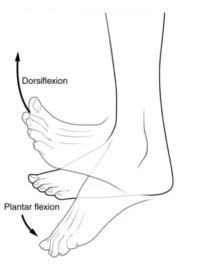 of the ankle and attaches to the outside of the foot from the top, so its action is different. It helps the other fibs with eversion but also acts more strongly to pull the front of the foot up, towards the head. This is called dorsiflexion.
of the ankle and attaches to the outside of the foot from the top, so its action is different. It helps the other fibs with eversion but also acts more strongly to pull the front of the foot up, towards the head. This is called dorsiflexion.
The Fibs work with tibialis posterior and tibialis anterior – the “Tibs” – to create a sort of “stirrup” under the foot. This helps us do some vertical “steering” with the Tibs and Fibs.
Postural Functions of the Fibularis Group
Of course, unless our ankles feel stiff, we don’t really perform any of these movements consciously. We activate them without moving our foot or ankle when we are standing still. It is part of how we maintain our balance. Think of the Tibs and Fibs as our lower “outrigger” muscles. However, the same idea applies when we are walking or running. They work to maintain balance then too, especially on uneven surfaces.
“Co-contractions of the tibialis posterior and fibularis longus may help support the medial arch and prevent hyperpronation of the foot, especially in runners”
During level walking, the Fibs work in concert with the Tibs to control the change from inversion (supination) early in our stance to a neutral position as we progress. This is critical for maintaining a normal gait. Along with the soleus, the Fibs and Tibs decelerate the movement of the leg over the fixed foot during walking or running.

